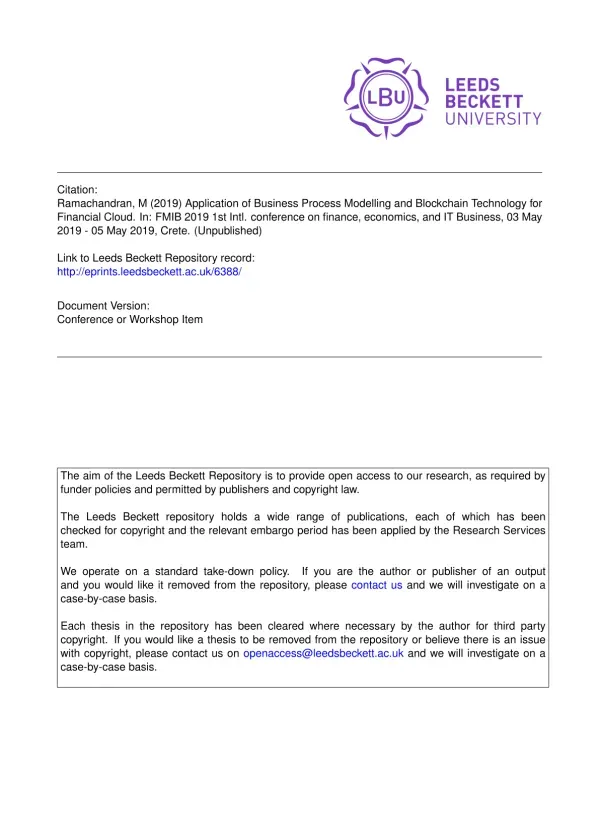
Application of Business Process Modelling and Blockchain Technology in Financial Cloud Services
Document information
| Author | M Ramachandran |
| instructor | Dr Muthu Ramachandran, PhD FBCS Fellow of Advance HE, MIEEE, MACM |
| School | Leeds Beckett University |
| Major | Software Engineering Technologies and Emerging Practices |
| Document type | conference or workshop item |
| Year of publication | 2019 |
| Place | Crete |
| Language | English |
| Number of pages | 68 |
| Format | |
| Size | 4.82 MB |
- Business Process Modelling
- Blockchain Technology
- Financial Cloud
Summary
I. Introduction to Business Process Modelling and Blockchain Technology
The integration of Business Process Modelling (BPM) and Blockchain Technology in financial cloud services represents a significant advancement in the digital economy. The document emphasizes the necessity of a systematic approach to enhance financial processes and applications. The digital economy has spurred growth, yet it has also introduced challenges such as social and economic instability. To address these issues, the application of Business Integrity Modelling and Analysis (BIMA) alongside BPM techniques is crucial. These methodologies aim to unify business integrity with performance, leveraging intelligent big data analytics. The document highlights that BPMN (Business Process Model and Notation) serves as a foundational tool for financial applications as a service, facilitating a structured approach to process management.
1.1 The Role of Digital Economy
The digital economy has transformed traditional financial services, creating new opportunities and challenges. The document notes that advancements in information technology have led to a surge in digital currencies and financialization. However, this growth necessitates a robust framework to ensure regulatory compliance and ethical governance. The integration of BPM and blockchain can mitigate risks associated with these challenges, fostering a more stable financial environment. The emphasis on predictive analytics and business intelligence further underscores the importance of data-driven decision-making in navigating the complexities of the digital landscape.
II. Application of BPM and Blockchain in Financial Services
The document outlines the practical applications of BPM and Blockchain Technology in financial services, particularly in enhancing operational efficiency and transparency. By employing BPMN, organizations can model their processes effectively, ensuring that all aspects of financial transactions are accounted for. The adoption of blockchain technology introduces a decentralized trust mechanism, which is vital for secure transactions. The document cites that blockchain can significantly reduce fraud and enhance customer trust, as it provides an immutable record of transactions. This integration not only streamlines operations but also aligns with the growing demand for fintech solutions that prioritize security and efficiency.
2.1 Benefits of Blockchain in Financial Cloud Services
The advantages of incorporating Blockchain Technology into financial cloud services are manifold. The document highlights that blockchain facilitates real-time transaction processing, which is essential for modern financial operations. Additionally, the technology supports the development of smart contracts, automating processes and reducing the need for intermediaries. This not only lowers costs but also accelerates transaction times. The document emphasizes that the combination of BPM and blockchain can lead to innovative financial products and services, ultimately enhancing customer satisfaction and loyalty.
III. Challenges and Future Directions
Despite the promising applications of BPM and Blockchain Technology, the document acknowledges several challenges that must be addressed. Issues such as regulatory compliance, data privacy, and the integration of legacy systems pose significant hurdles. The document suggests that a collaborative approach among stakeholders, including regulators, financial institutions, and technology providers, is essential for overcoming these challenges. Furthermore, ongoing research and development in fintech are crucial for adapting to the rapidly evolving landscape of financial services. The document concludes with a call for continued innovation and exploration of new technologies to enhance the effectiveness of financial cloud services.
3.1 The Importance of Collaboration
Collaboration among various stakeholders is vital for the successful implementation of BPM and blockchain in financial services. The document stresses that financial institutions must work closely with technology providers to ensure that solutions are tailored to meet regulatory requirements and customer needs. Additionally, fostering a culture of innovation within organizations can lead to the development of cutting-edge solutions that address emerging challenges. The document highlights that the future of financial services will depend on the ability to adapt and integrate new technologies while maintaining a focus on customer-centric approaches.
